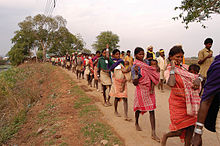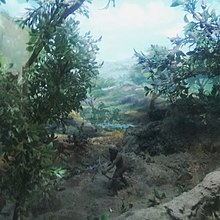A particularly vulnerable tribal group or PVTG (previously known as a primitive tribal group), in the context of India, is a sub-classification of Scheduled Tribe or section of a Scheduled Tribe, that is considered more vulnerable than a regular Scheduled Tribe. The PVTG list was created by the Indian Government with the purpose of better improving the living standards of endangered tribal groups based on priority. PVTGs reside in 18 states and one union territory.


Origin of the concept
The Dhebar Commission (1960-1961) found that within the Scheduled Tribe classification an inequality existed in the rate of development of certain tribes over others. As a result in the fourth Five Year Plan the sub-category "Primitive tribal group" was created within the grouping of Scheduled Tribe to identify groups considered to be especially lacking in modern development. The features of such a group include a pre-agricultural system of existence, that is practice of hunting and gathering, zero or negative population growth, and extremely low levels of literacy in comparison with other tribal groups.
Groups that satisfied any of the criteria were considered to be a Primitive Tribal Group. At the conclusion of the Fifth Five year plan, 52 communities were identified as being a "primitive tribal group" based on recommendations made by Indian state governments. At the conclusion of the Sixth Five year plan 20 additional groups were added and 2 more were added in the Seventh Five year plan and finally one more group was added in the eighth five-year plan, for a total 75 groups were identified as Primitive Tribal Group. The 75th group recognised as PTG were the Maram in Manipur in 1993-94. No new group was declared as PTG on the basis of the 2001 census.
In 2006 the government of India changed the name of "Primitive tribal group" to "Particularly vulnerable tribal group" PTG has since been renamed Particularly vulnerable tribal group by the government of India.

Other issues
Until 2018 Particularly Vulnerable Tribal Groups were not allowed contraceptive use by the Indian Government because of their often declining or stagnant population growth. Based on the assumption that allowing them to use contraception would hamper efforts to increase the size of their populations. However in 2018 the High Court of Chhattisgarh in a Public Interest Litigation found this to be a violation of their right to privacy and ruled that they had the right to contraceptives. The PVTG of Chhattisgarh got these rights amidst concerns of family planning amongst many of them particularly the Baigas.
List
| Sl. No. | Name of PVTG | Notified State | Population (2011) |
|---|---|---|---|
| 1 | Chenchu | Andhra Pradesh | 64227 |
| 2 | Bodo Gadaba | 38081 | |
| 3 | Gutob Gadaba | ||
| 4 | Dongria Khond | 103290 | |
| 5 | Kultia Khond | ||
| 6 | Kolam | 44912 | |
| 7 | Konda Reddi | 107747 | |
| 8 | Kondasavara | 139424 | |
| 9 | Bondo Porja | - | |
| 10 | Khond Porja | - | |
| 11 | Parengi Proja | 36502 | |
| 12 | Thoti | 4811 | |
| 13 | Asur | Bihar | 4129 |
| 14 | Birhor | 377 | |
| 15 | Birjia | 208 | |
| 16 | Hill Kharia | 11569 | |
| 17 | Korwa | 452 | |
| 18 | Mal Paharia | 2225 | |
| 19 | Parhaiya | 647 | |
| 20 | Sauria Paharia | 1932 | |
| 21 | Savar | 80 | |
| 29 | Kolgha | Gujarat | 67119 |
| 30 | Kathodi | 13632 | |
| 31 | Kotwalia | 24249 | |
| 32 | Padhar | 30932 | |
| 33 | Siddi | 8661 | |
| 34 | Asur | Jharkhand | 22459 |
| 35 | Birhor | 10726 | |
| 36 | Birjia | 6276 | |
| 37 | Hill Kharia | 196135 | |
| 38 | Korwa | 35606 | |
| 39 | Mal Paharia | 135797 | |
| 40 | Parhaiya | 25585 | |
| 41 | Sauria Paharia | 46222 | |
| 42 | Savar | 9688 | |
| 43 | Jenu Kuruba | Karnataka | 36076 |
| 44 | Koraga | 14794 | |
| 45 | Cholanai- kayan | Kerala | 124 |
| 46 | Kadar | 2949 | |
| 47 | Kattunayakan | 18199 | |
| 48 | Koraga | 1582 | |
| 49 | Kurumba | 2586 | |
| 50 | Abujh Maria | Madhya Pradesh and Chhattisgarh | 5093124 |
| 51 | Baiga | 414526 | |
| 52 | Bharia | 193230 | |
| 53 | Birhor | 52 | |
| 54 | Hill Korwa | - | |
| 55 | Kamar | 666 | |
| 56 | Sahariya | 165 | |
| 57 | Katkari/ Kathodi | 285334 | |
| 58 | Kolam | 194671 | |
| 59 | Maria Gond | 1618090 | |
| 60 | Maram Naga | Manipur | 27524 |
| 61 | Chuktia Bhunjia | Orisha | 2378 |
| 62 | Birhor | 596 | |
| 63 | Bondo | 12231 | |
| 64 | Didayi | 8890 | |
| 65 | Dongria Khond | 6306 | |
| 66 | Juang | 47095 | |
| 67 | Kharia | 222844 | |
| 68 | Kutia Khond | 7232 | |
| 69 | Lanjia Saura | 5960 | |
| 70 | Lodha | 9785 | |
| 71 | Mankirdia | 2222 | |
| 72 | Paudi Bhuyan | 5788 | |
| 73 | Saura | 534751 | |
| 74 | Saharia | Rajasthan | 1,11,377 |
| 75 | Irular | Tamil Nadu | 189661 |
| 76 | Kattunayakan | 46672 | |
| 77 | Kota | 308 | |
| 78 | Korumba | 6823 | |
| 79 | Paniyan | 10134 | |
| 80 | Toda | 2002 | |
| 81 | Riang | Tripura | 1,88,220 |
| 82 | Buksa | Uttar Pradesh | 4710 |
| 83 | Raji | 2241 | |
| 84 | Buksa | Uttrakhand | 4710 |
| 85 | Raji | 1295 | |
| 86 | Birhor | West Bengal | 2241 |
| 87 | Lodha | 1,08,707 | |
| 88 | Toto | 66627 | |
| 89 | Great Andamanese | Andaman & Nico- bar Islands | 44 |
| 90 | Jarawa | 380 | |
| 91 | Onge | 101 | |
| 92 | Sentinelese | 15 | |
| 93 | Shompen | 229 |
References
- B. M. L. Patel (1 January 1998). Agrarian Transformation In Tribal India. M.D. Publications Pvt. Ltd. pp. 313–. ISBN 978-81-7533-086-3. Retrieved 2 April 2013.
- "Revised scheme of "Development of Particularly Vulnerable Tribal Groups" - PVTGs" (PDF). tribal.nic.in. Archived (PDF) from the original on 25 May 2022. Retrieved 27 Jun 2022.
- Ram Nath Sharma; Dr. Rajendra K. Sharma (2004). Problems Of Education In India. Atlantic Publishers & Dist. pp. 46–. ISBN 978-81-7156-612-9. Retrieved 2 April 2013.
- ^ Jasodhara Bagchi; Sarmistha Dutta Gupta (2005). The Changing Status of Women in West Bengal, 1970-2000: The Challenge Ahead. SAGE Publications. p. 130. ISBN 978-0-7619-3242-0. Retrieved 2 April 2013.
- ^ Sarit Kumar Chaudhuri; Sucheta Sen Chaudhuri (2005). Primitive Tribes in Contemporary India: Concept, Ethnography and Demography. Mittal Publications. p. 2. ISBN 978-81-8324-026-0. Retrieved 2 April 2013.
- Bhagyalaxmi Mahapatra (2011). Development of a Primitive Tribe: A Study of Didayis. Concept Publishing Company. pp. 47–49. ISBN 978-81-8069-782-1. Retrieved 2 April 2013.
- Komol Singha (2011). Economy of a Tribal Village. Concept Publishing Company. p. 21. ISBN 978-81-8069-745-6. Retrieved 2 April 2013.
- Laxmikanth. Governance In India. McGraw-Hill Education (India) Pvt Limited. pp. 14–. ISBN 978-0-07-107466-7. Retrieved 2 April 2013.
- "Misconstruing order, Chhattisgarh tribals denied sterilisation for three decades". 2012-10-31. Retrieved 3 April 2013.
- Bhuyan, Anoo. "Tribal Women in Chhattisgarh Win Right to Access Contraception". The wire. Archived from the original on 2021-05-06. Retrieved 2020-09-01.